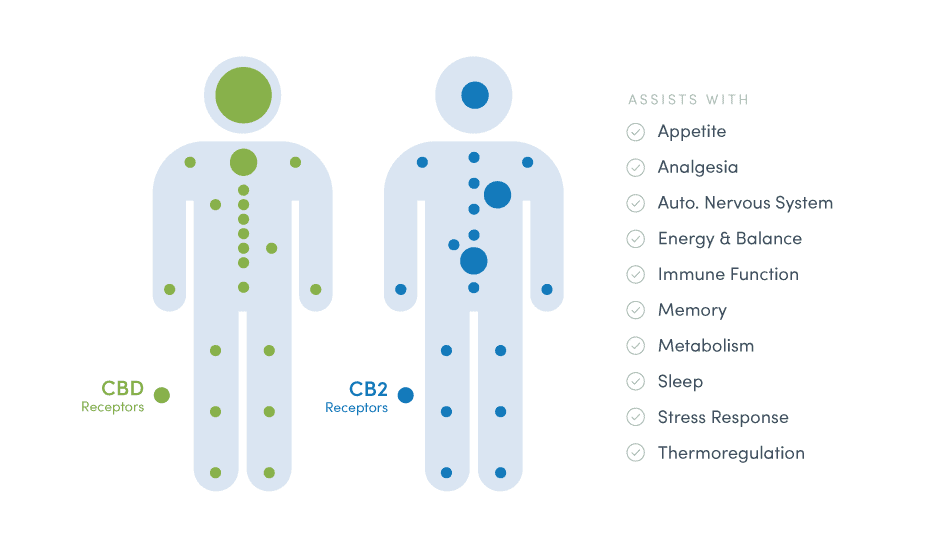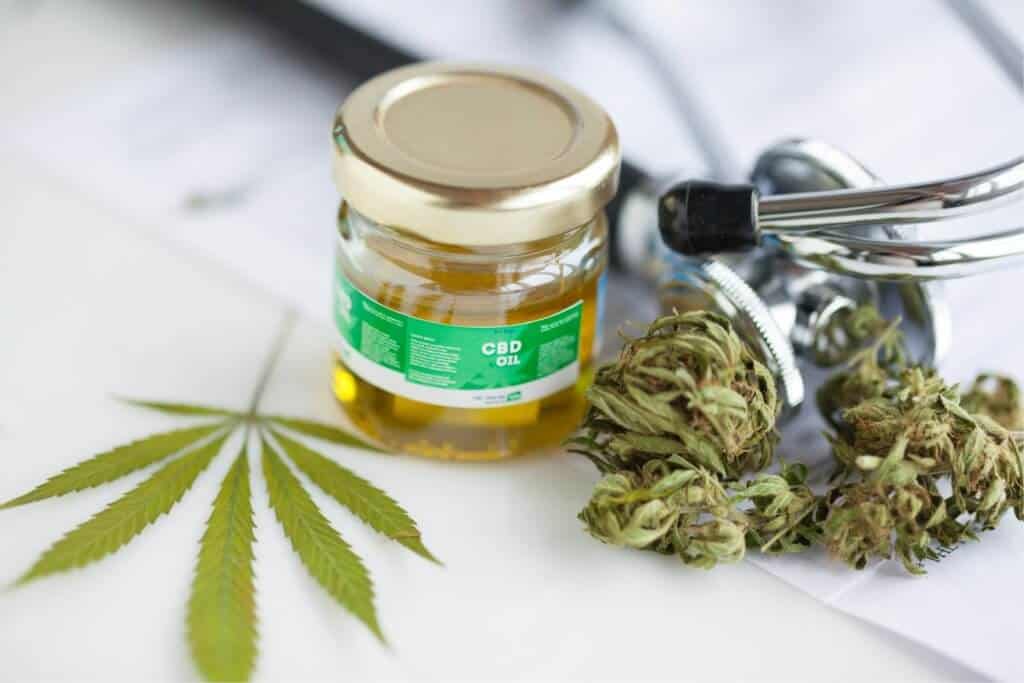What is the endocannabinoid system?
In order to discuss the therapeutic potential of CBD, it is first important to understand the role and function of the endocannabinoid system (ECS) within the body. The endocannabinoid system is a lipid signaling system made up of enzymes, endogenous cannabinoids, and cannabinoid receptors. (8)(10)(19) The ECS is found within the central and peripheral nervous systems, where it is involved in regulating many body functions, (15)(19) as well as modulating the immune system, autonomic nervous system, and microcirculation. (19) Within the ECS, the two primary cannabinoid receptors are known as type 1 (CB1) and type 2 (CB2). (16) These receptors are activated by endocannabinoids, which are endogenous lipid chemical mediators. (9) Found abundantly in the brain, (16) CB1 receptors appear to be directly involved in many functions, including behavior, emotions, cognition, motor control, homeostasis, (19) reproduction, sexual behavior, appetite, and energy balance. (16) CB1 receptors are also believed to play a role in the hypothalamic-pituitary-adrenal axis and hypothalamic-peripheral endocrine axes. CB2 receptors are found primarily in immune and blood cells, where they play an important part in regulating immune function. (16)
A promising new therapeutic approach
While our knowledge of the endocannabinoid system and its functions continues to grow, evidence supports the implication of the ECS in disease as alterations in endocannabinoid activity and receptor expression has been observed in a number of pathologies. (9)(10) Research has demonstrated that certain factors have the ability to prolong or inhibit the actions of endocannabinoids, (9) suggesting that modulation of ECS activity may be an effective therapeutic target for various health conditions, including:- Atherosclerosis
- Cancer
- Glaucoma
- Hypertension
- Myocardial infarction
- Stroke
- Mood and anxiety disorders
- Movement disorders (e.g., Huntington’s, Parkinson’s diseases)
- Multiple sclerosis
- Neuropathic pain
- Spinal cord injury
- Osteoporosis
- Obesity/metabolic syndrome (15)
What is CBD?
In addition to endogenous cannabinoids and synthetic cannabinoids, research has also identified more than one hundred different cannabinoids in the Cannabis sativa plant called “phytocannabinoids’. The two most abundant and commonly researched phytocannabinoids are tetrahydrocannabinol (THC) and cannabidiol (CBD). While both THC and CBD are thought to have therapeutic potential, unlike THC, CBD does not induce psychotropic effects. (12)(13) Similarly to endocannabinoids, CB1 and CB2 have been established as the primary molecular targets for phytocannabinoids, including CBD. As the modulation of CB1 and CB2 receptors have been shown to be involved in many body functions and pathologies, it is in this way that phytocannabinoids are believed to affect body functions. (16)What is CBD oil?
CBD a fat-soluble compound (5) available in oral supplements as CBD oil, where CBD extract is generally diluted in a base or carrier oil. For example, hemp seed oil is used as a carrier in products known as CBD hemp oil. CBD can be supplemented in various forms, including vaporized, taken orally as CBD oil, liquid tincture, gummies, or capsules, and applied topically in creams or ointments.
CBD benefits
While still in the early stages, there is a growing body of research aimed at examining the effects of CBD in the treatment of several health conditions, such as epilepsy, pain, and anxiety.CBD for epilepsy
CBD decreases the frequency of seizures and appears to be an effective tool in treating treatment-resistant epilepsy when used in conjunction with anti-epileptic medications. A double-blind, placebo-controlled trial examined the efficacy of CBD when used in conjunction with antiepileptic medication in patients with Lennox-Gastaut syndrome experiencing at least two seizures per week. Patients were given 20 mg/kg of oral CBD, 10 mg/kg of oral CBD, or a placebo for 14 weeks. Seizure frequency decreased 41.9% in patients receiving 20 mg of CBD, 37.2% in patients receiving 10 mg of CBD, and 17.2% in the placebo group. (7) Another study found similar results when CBD was administered as an adjunct to antiepileptic medications in patients with tuberous sclerosis complex (TSC)-related seizures. A 5mg/kg per day dose of CBD was administered, increasing 5 mg/kg per day every week to a maximum dose of 50 mg/kg per day. After three months, the median percentage change in seizure frequency decreased by 48.8%. Another open-label trial found that CBD was effective in decreasing the frequency of seizures in children and young adults with treatment-resistant epilepsy when used in combination with existing antiepileptic medications. (6) While these results demonstrate promise for the use of CBD in treatment-resistant epilepsy, further placebo-controlled trials are necessary. Research thus far has also been limited to the use of CBD as an adjunct to pharmaceuticals and the effects of CBD on its own has not yet been determined.CBD for pain
While many studies have highlighted the analgesic effects of vaporized cannabis (4)(22)(23), some studies demonstrate that CBD extract may provide similar benefits. CBD may improve chronic pain in kidney transplant patients. Seven patients between the ages of 58 and 75 received 50 mg to 150 mg of CBD twice per day over three weeks. Results demonstrated total pain improvement in two patients, partial improvement in four patients, and no change in only one patient. (5) Another study examined the short-term effects of CBD-enriched hemp oil in young girls with adverse drug effects (ADRs) following the human papillomavirus (HPV) vaccine. Administration sublingual CBD hemp oil drops in doses of 25 mg/kg per day and 2-5 mg/ml CBD once a week up to a maximum dose of 150 mg/ml CBD per day resulted in significant reductions in pain and improvements in physical component, vitality, and social role functioning scores. (17) A series of double-blind, randomized, placebo-controlled, single-patient, cross-over trials examined the effects of medicinal cannabis extracts on neurogenic symptoms in patients with treatment-resistant multiple sclerosis, spinal cord injury, brachial plexus damage, or limb amputation due to neurofibromatosis. Patients were instructed to self-administer sublingual sprays of a placebo, delta-9-tetrahydrocannabinol (THC), cannabidiol (CBD), or 1:1 CBD:THC whole-plant extracts. Both THC and CBD resulted in significant pain relief compared to the placebo. Some patients with poor bladder control, muscle spasms, and spasticity also experienced improvements in these symptoms. (21)CBD for anxiety
Studies have demonstrated the therapeutic properties of CBD for anxiety. One double-blind trial even demonstrated that CBD may reduce THC-induced anxiety, suggesting an antagonistic action between CBD and THC. (28) Two studies were conducted to examine the effects of various doses of CBD for anxiety induced by the performance of a simulated public speaking test. In the first study, 60 subjects were randomly assigned to receive a placebo, clonazepam, or CBD (100 mg, 300 mg, or 900 mg). Results demonstrated a reduction in subjective anxiety measures in individuals taking 300 mg of CBD, but those taking 100 mg and 900 mg did not demonstrate the same effects. (27) Similarly, in another double-blind trial, 57 male subjects performing a simulated public speaking test were given 150 mg, 300 mg, or 600 mg of CBD, or a placebo. When administered prior to the speech, 300 mg of CBD reduced anxiety, while no significant differences were observed in groups receiving the placebo, 150 mg of CBD, or 600 mg of CBD. (13) The results of these studies suggest that the beneficial effects of CBD for anxiety follow a dose-dependent inverted U-shaped curve. (13)(27)CBD for schizophrenia
CBD is believed to have antipsychotic effects and may be effective in treating neurodegenerative conditions. While some studies have examined the use of CBD in the treatment of schizophrenia, evidence is conflicting. In a 2018 exploratory double-blind, parallel-group trial, patients with schizophrenia received 100 mg/day of CBD or a placebo in conjunction with their current antipsychotic medications. Patients in the CBD group demonstrated lower positive psychotic symptoms, suggesting that CBD may be beneficial in the treatment of schizophrenia. Although not statistically significant, the CBD group also demonstrated greater improvements in cognitive performance and overall functioning compared to the placebo group. (14) However, in another placebo-controlled study conducted the same year, 600 mg/day of CBD did not result in improvements in MATRICS Consensus Cognitive Battery (MCCB) or Positive and Negative Syndrome Scale (PANSS) scores in antipsychotic-treated schizophrenic patients. (2)CBD side effects
Adverse effects of CBD have been noted in clinical trials. Common CBD side effects include somnolence/drowsiness, appetite reduction, gastrointestinal disturbances, headaches, dizziness, ataxia, convulsions, and elevated liver aminotransferase concentrations. (5)(6)(7)(11)
Guidelines for working with CBD
The following guidelines can be applied when recommending CBD products:1. “Start low and Go Slow”
While CBD has shown promise in a number of areas, it is still a relatively new therapeutic tool and prescribing standards are still being established. The best approach when it comes to dosing is to “Start Low and Go Slow”, meaning start treatment at a low dose and increase incrementally, noting that dose dependence seems to vary patient to patient.2. Determine dosing with the equivalency factor
CBD extracts typically start at 10 mg or 1 ml CBD oil per day dosing. Look at the equivalency factor in dosing to calculate the quantity of CBD being consumed per dose.3. Consider full-spectrum products
When looking for CBD products, you will find both CBD extracts and full-spectrum hemp products. While full-spectrum hemp products contain CBD, THC, and several other phytocannabinoids, CBD extracts are produced by isolating the CBD content, removing THC and other cannabinoids. It’s important to note that hemp-derived products will contain less than 0.3% THC, unless they’re isolated CBD extracts. Research suggests that full-spectrum hemp products may induce additional therapeutic benefits through the synergistic actions of CBD, THC, and various other phytocannabinoids. This synergy between phytocannabinoids is known as the “entourage effect”. (18)(20)4. Determine possible interactions
Several animal and in-vitro studies have noted interactions between CBD and cytochrome P450 enzymes. Specifically, research has shown that CBD may inhibit CYP1A1, CYP1A2, CYP1B1, (25) CYP2D6 (26), and CYP2C (3) and CYP3A (3)(24) subfamilies. Therefore, CBD could potentially interact with certain medications that are cytochrome P450 substrates. Be sure to consider other medications and supplements a patient is taking to limit any potential negative interactions.5. Look for quality
To ensure the best quality, be sure to purchase CBD products from a reputable source. Products should be manufactured in a facility compliant to cGMP standards and each batch should have an associated certificate of analysis. Some manufacturers will also have independent third party, ISO-accredited laboratory testing of their products, and certifications like US Hemp Authority, which traces ingredient sourcing.The bottom line
While research has demonstrated some promise in the treatment of epilepsy, anxiety, pain, the literature surrounding the effects and potential benefits of CBD is still in its early stages. When it comes to prescribing CBD, it’s best to exercise caution as more research emerges and therapeutic standards are established.- Barna Bridgeman, M., & Abazia, D.T. (2017). Medicinal cannabis: History, pharmacology, and implications for the acute care setting. Pharmacy and Therapeutics, 42(3), 180–188.
- Boggs, D.L., Surti, T., Gupta, A., Gupta, S., Niciu, M., Pittman, B., … Ranganathan, M. (2018). The effects of cannabidiol (CBD) on cognition and symptoms in outpatients with chronic schizophrenia a randomized placebo controlled trial. Psychopharmacology (Berl), 235(7),1923-1932.
- Bornheim, L.M., Everhart, E.T., Li, J., & Correia, M.A. (1993). Characterization of cannabidiol-mediated cytochrome P450 inactivation. Biochemical Pharmacology, 45(6), 1323-31.
- Corey-Bloom, J., Wolfson, T., Gamst, A., Jin, S., Marcotte, T.D., Bentley, H., & Gouaux, B. (2012). Smoked cannabis for spasticity in multiple sclerosis: a randomized, placebo-controlled trial. CMAJ, 184(10), 1143-50.
- Cuñetti, L., Manzo, L., Peyraube, R., Arnaiz, J., Curi, L., & Orihuela, S. (2018). Chronic pain treatment with cannabidiol in kidney transplant patients in Uruguay. Transplantation Proceedings, 50(2), 461-464.
- Devinsky, O., Marsh, E., Friedman, D., Thiele, E., Laux, L., Sullivan, J., … Cilio, M.R. (2016). Cannabidiol in patients with treatment-resistant epilepsy: an open-label interventional trial. Lancet Neurology, 15(3), 270-8.
- Devinsky, O., Patel, A.D., Cross, J.H., Villanueva, V., Wirrell, E.C., Privitera, M., … Zuberi, S.M. (2018). Effect of cannabidiol on drop seizures in the Lennox-Gastaut Syndrome. New England Journal of Medicine, 378(20), 1888-1897.
- Dhopeshwarkar, A., & Mackie, K. (2014). CB2 cannabinoid receptors as a therapeutic target—What does the future hold? Molecular Pharmacology, 86(4), 430–437.
- Di Marzo, V. (2008). Targeting the endocannabinoid system: to enhance or reduce? Nature Reviews Drug Discovery, 7, 438–455.
- Di Marzo, V., Bifulco, M., & De Petrocellis, L. (2004). The endocannabinoid system and its therapeutic exploitation. Nature Reviews Drug Discovery, 3, 771–784.
- Hess, E.J., Moody, K.A., Geffrey, A.L., Pollack, S.F., Skirvin, L.A., Bruno, P.L., … Thiele, E.A. (2016). Cannabidiol as a new treatment for drug-resistant epilepsy in tuberous sclerosis complex. Epilepsia, 57(10), 1617-1624.
- Ligresti, A., De Petrocellis, L., & Di Marzo, V. (2016). From phytocannabinoids to cannabinoid receptors and endocannabinoids: Pleiotropic physiological and pathological roles through complex pharmacology. Physiological Reviews, 96(4), 1593-1659.
- Linares, I.M., Zuardi, A.W., Pereira, L.C., Queiroz, R.H., Mechoulam, R., Guimarães, F.S., & Crippa, J.A. (2019). Cannabidiol presents an inverted U-shaped dose-response curve in a simulated public speaking test. Brazilian Journal of Psychiatry, 41(1), 9-14.
- McGuire, P., Robson, P., Cubala, W.J., Vasile, D., Morrison, P.D., Barron, R., … Wright, S. (2018). Cannabidiol (CBD) as an adjunctive therapy in schizophrenia: A multicenter randomized controlled trial. American Journal of Psychiatry, 175(3), 225-231.
- Pacher, P., Bátkai, S., & Kunos, G. (2006). The endocannabinoid system as an emerging target of pharmacology. Pharmacological Reviews, 58(3), 389-462.
- Pagotto, U., Marsicano, G., Cota, D., Lutz, B., & Pasquali, R. The emerging role of the endocannabinoid system in endocrine regulation and energy balance. Endocrine Reviews, 27(1), 73–100.
- Palmieri, B., Laurino, C., & Vadalà, M. (2017). Short-term efficacy of CBD-enriched hemp oil in girls with Dysautonomic Syndrome after Human Papillomavirus Vaccination. The Israel Medical Association Journal, 19(2), 79-84.
- Pamplona, F.A., da Silva, L.R., & Coan, A.C. (2018). Potential clinical benefits of CBD-rich cannabis extracts over purified CBD in treatment-resistant epilepsy: Observational data meta-analysis. Frontiers in Neurology, 9, 759.
- Rodriguez de Fonseca, F., Del Arco Francisco, I., Bermudez-Silva, J., Bilbao, A., Cippitelli, A., & Navarro, M. (2005). The endocannabinoid system, Physiology and pharmacology. Alcohol and Alcoholism, 40(1), 2–14.
- Russo, E.B. (2019). The case for the entourage effect and conventional breeding of clinical cannabis: No “strain,” no gain. Frontiers in Plant Science, 9, 1969.
- Wade, D.T., Robson, P., House, H., Makela, P., & Aram, J. (2003). A preliminary controlled study to determine whether whole-plant cannabis extracts can improve intractable neurogenic symptoms. Clinical Rehabilitation, 17(1), 21-9.
- Wilsey, B., Marcotte, T., Deutsch, R., Gouaux, B., Sakai, S., & Donaghe, H. (2013). Low-dose vaporized cannabis significantly improves neuropathic pain. The Journal of Pain, 14(2), 136-48.
- Wilsey, B., Marcotte, T.D., Deutsch, R., Zhao, H., Prasad, H, & Phan, A. (2016). An exploratory human laboratory experiment evaluating vaporized cannabis in the treatment of neuropathic pain from spinal cord injury and disease. The Journal of Pain, 17(9), 982-1000.
- Yamaori, S., Ebisawa, J., Okushima, Y., Yamamoto, I., & Watanabe, K. (2011). Potent inhibition of human cytochrome P450 3A isoforms by cannabidiol: role of phenolic hydroxyl groups in the resorcinol moiety. Life Sciences, 88(15-16), 730-6.
- Yamaori, S., Kushihara, M., Yamamoto, I., & Watanabe, K. (2010). Characterization of major phytocannabinoids, cannabidiol and cannabinol, as isoform-selective and potent inhibitors of human CYP1 enzymes. Biochemical Pharmacology, 79(11), 1691-8.
- Yamaori, S., Okamoto, Y., Yamamoto, I., & Watanabe, K. (2011). Cannabidiol, a major phytocannabinoid, as a potent atypical inhibitor for CYP2D6. Drug Metabolism and Disposition, 39(11), 2049-56.
- Zuardi, A.W., Rodrigues, N.P., Silva, A.L., Bernardo, S.A., Hallak, J.E.C., Guimarães, F.S., & Crippa, J.A.S. (2017). Inverted U-shaped dose-response curve of the anxiolytic effect of cannabidiol during public speaking in real life. Frontiers in Pharmacology, 8, 259.
- Zuardi, A.W., Shirakawa, I., Finkelfarb, E., & Karniol, I.G. (1982). Action of cannabidiol on the anxiety and other effects produced by delta 9-THC in normal subjects. Psychopharmacology (Berl), 76(3), 245-50.





